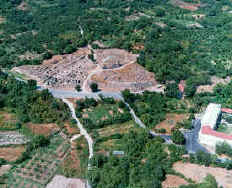..from neolithic times... |
Edessa city of waters |
... till nowadays | |
| Ancient Edessa (Hydor=water, Hyd-essa=city of waters) | |||
|
The ancient town of Edessa was built on a natural passage. There, the age-long road axis was renamed to VIA EGNATIA since the 2nd century B.C. The ancient town in the plain of Loggos was gradually abandoned and habitation occurred in the upper town in the mountainous Macedonia. This choice was made because of the waters which were a perfect defensive system and offered fortification. The
oldest finds are from the Neolithic times but the most are from the copper
age and mainly from the iron age. In the 6th – 5th century B.C. ancient
Edessa developed in two levels : the Upper town or Acropolis and the lower
town on Loggos. Nowadays after the excavation parts of the ancient walls
parts of buildings of the Acropolis can be seen as well as the old toms of
various types which are in the lower town. After 168 B.C. and the conquest
by the Romans the town knows prosperity and has its own mintages made
which show the participation of the town in the retention of the road axis
Via Egnatia. A large number of inscriptions ensure the existence of
parliament, a high school, as well as the temple of Dionysus Pseudanor
also the temple dedicated to Goddess Ma, the mother of Gods, other
monuments show the worship of Goddess Artemis and the Phrygian God
Savazios .During the second half of the 3rd century A.D. the town suffered of numerous raids by Goths. This led to a quick reparation of the ancient wall in order to make the town more secure. The
inhabitants used buildings material which they took from the neighboring
tomb. Among these is also the anaglyph of ‘the Hog’ that reportedly
passed together with his master the Via Egnatia from Dirachio to Edessa to
take part in the great Macedonian feast of the Phallocrats ( dedicated to
God Dionysus ) During Christian times was the wall strengthened with a new
fortified line in a distance of 6 km next to the old one. In the end of
the 6th beginning of the 7th century the inhabitants gradually abandon the
lower town and inhabitation occurs in the Acropolis which develops into a
Byzantine fortress. The most important monuments of the area are: The
South gate: made with the early fortress art which is described in ancient
handbooks. The monumental marble-paved road which crossed the town ,
columns of marble and built pessaries can be seen at each side. One of the
columns there are many inscriptions of independence. The
fortress of Edessa
is one of the best preserved in Macedonia. It was constructed in 300 B.C.
and repetedly repaired. The
Acropolis was fortified by a wall, which now survives to a height of 6m.
Parts of it can be seen through windows beneath apartment buildings |
The Ancient City
Main Entrance, Via Colloonata
|
||
Anastasia Crisostomou XVI Directory of Ancient Monuments - Edessa. |
|||
| You can see .... | |||
| Buildings at the ancient city | Kions | ||
| Cemeteris | North Entrance | ||
| Gold Coins (Roman Times) | |||
| Parts of the wall - Acropolis | The bas-relief of HIROS | ||
Main Entrance |
Parts of the wall - MAin Entrance | ||
| Tours | |||
| Edessa | |||


